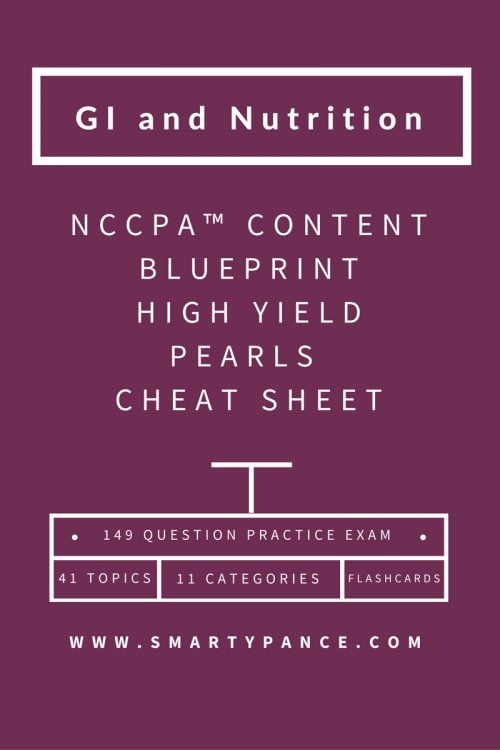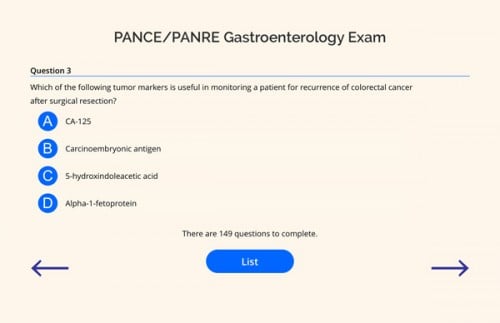 The NCCPA™ PANCE and PANRE GI and Nutrition Content Blueprint
The NCCPA™ PANCE and PANRE GI and Nutrition Content Blueprint
- 6 types of Diseases of the Esophagus
- 5 types of Disorders of the Stomach
- 3 types of Diseases of the Gallbladder
- 3 types of Disorders of the Liver
- 2 types of Disorders of the Pancreas
- 13 types of Diseases of the Small Intestine and Colon
- 5 types of Disorders of the Anus and Rectum
- Hernias, Infectious and Noninfectious diarrhea, Vitamin and nutritional deficiencies and Metabolic Disorders
Total: 41 conditions
GU Blueprint Course
Diseases of the Esophagus (PEARLS)The NCCPA™ Gastroenterology and Nutrition PANCE and PANRE Content Blueprint covers 6 topics under category esophageal disorders |
||||||||||||||||||||||||||||||||||||||||||||||||||||||||||||||
|---|---|---|---|---|---|---|---|---|---|---|---|---|---|---|---|---|---|---|---|---|---|---|---|---|---|---|---|---|---|---|---|---|---|---|---|---|---|---|---|---|---|---|---|---|---|---|---|---|---|---|---|---|---|---|---|---|---|---|---|---|---|---|
| Esophagitis (ReelDx) | Non-infectious
Infectious:
|
|||||||||||||||||||||||||||||||||||||||||||||||||||||||||||||
| Motility disorders | Achalasia: Bird/Parrot beak on barium swallow
Diffuse Esophageal Spasm: Corkscrew appearance on barium swallow Neurogenic dysphagia: Dysphagia to liquids and solids Zenker diverticulum: Causes regurgitation of undigested food and liquid into the pharynx several hours after eating Scleroderma esophagus: Dysphagia to both solids and liquids Esophageal stenosis: Dysphagia to solids |
|||||||||||||||||||||||||||||||||||||||||||||||||||||||||||||
| Mallory Weiss tear | History of alcohol intake and an episode of vomiting with blood, upper endoscopy showing superficial longitudinal mucosal erosions. | |||||||||||||||||||||||||||||||||||||||||||||||||||||||||||||
| Esophageal Neoplasms | Progressive dysphagia to solid foods along with weight loss, reflux and hematemesis, squamous cell m/c worldwide and adenocarcinoma common in US, complication of Barrett's esophagus (screen barrett's patients every 3-5 years with endoscopy), affects distal esophagus, | |||||||||||||||||||||||||||||||||||||||||||||||||||||||||||||
| Esophageal strictures | Solid food dysphagia in a patient with a history of GERD, Plummer-Vinson: esophageal webs + dysphagia + iron deficiency anemia, DX with barium swallow, treat with endoscopic dilation | |||||||||||||||||||||||||||||||||||||||||||||||||||||||||||||
| Esophageal varices (ReelDx) | Typically a complication of cirrhosis, treat with endoscopic banding and IV octreotide, prevent with nonselective beta blockers | |||||||||||||||||||||||||||||||||||||||||||||||||||||||||||||
Disorders of the Stomach (PEARLS)The NCCPA™ Gastroenterology and Nutrition PANCE and PANRE Content Blueprint covers 5 topics under the category disorders of the stomach. |
||||||||||||||||||||||||||||||||||||||||||||||||||||||||||||||
| Gastroesophageal reflux disease | Barrett's esophagus, PH Probe is gold standard for diagnosis | |||||||||||||||||||||||||||||||||||||||||||||||||||||||||||||
| Gastritis | NSAIDs and Alcohol, Endoscopy with biopsy is gold standard for diagnosis | |||||||||||||||||||||||||||||||||||||||||||||||||||||||||||||
| Neoplasms | Adenocarcinoma, Virchow's node (Supraclavicular), Sister Mary Joseph's node (Umbilical) | |||||||||||||||||||||||||||||||||||||||||||||||||||||||||||||
| Peptic ulcer disease | H Pylori, triple therapy CAP - Clarithromycin, Amoxicillin, PPI | |||||||||||||||||||||||||||||||||||||||||||||||||||||||||||||
| Pyloric stenosis | Projectile vomiting occurs shortly after feeding in an infant < 3 mo old, palpable "olive-like" mass | |||||||||||||||||||||||||||||||||||||||||||||||||||||||||||||
Diseases of the Gallbladder (PEARLS)The NCCPA™ Gastroenterology and Nutrition PANCE and PANRE Content Blueprint covers 3 topics associated with the gallbladder |
||||||||||||||||||||||||||||||||||||||||||||||||||||||||||||||
| Acute and chronic cholecystitis | (+) Murphy's sign (RUQ pain with GB palpation on inspiration), after high fat meal, fat-forty and fertile, diagnose with ultrasound, porcelain gallbladder = chronic cholecystitis | |||||||||||||||||||||||||||||||||||||||||||||||||||||||||||||
| Cholangitis | fever + jaundice + right upper abdominal pain (Charcot's triad), aggressive care and emergent removal of stones, cipro + metronidazole | |||||||||||||||||||||||||||||||||||||||||||||||||||||||||||||
| Cholelithiasis | precursor to cholecystitis, cholesterol stones account for > 85% of gallstones in the Western world | |||||||||||||||||||||||||||||||||||||||||||||||||||||||||||||
Disorders of the Liver (PEARLS)The NCCPA™ Gastroenterology and Nutrition Content Blueprint covers 3 topics under the category disorders of the liver |
||||||||||||||||||||||||||||||||||||||||||||||||||||||||||||||
| Acute and chronic hepatitis |
Hepatitis B Serology
Hepatitis C Serology
Hepatitis A Serology
|
|||||||||||||||||||||||||||||||||||||||||||||||||||||||||||||
| Cirrhosis (ReelDx) | Chronic hepatitis most common cause of cirrhosis
Skin changes: spider angiomata, palmar erythema, jaundice, scleral icterus, ecchymoses, caput medusae, hyperpigmentation Labs: typically AST > ALT, ↑ risk for hepatocellular carcinoma: monitor AFP, Hepatic vein thrombosis: Budd Chiari: triad of abdominal pain, ascites and hepatomegaly |
|||||||||||||||||||||||||||||||||||||||||||||||||||||||||||||
| Liver neoplasms (ReelDx) | Abdominal pain, weight loss, right upper quadrant mass, Hepatitis B and C will increase the risk of hepatocellular carcinoma, ↑ alpha-fetoprotein and abnormal liver imaging | |||||||||||||||||||||||||||||||||||||||||||||||||||||||||||||
Disorders of the Pancreas (PEARLS)The NCCPA™ Gastroenterology and Nutrition Content Blueprint covers 2 topics under disorders of the pancreas |
||||||||||||||||||||||||||||||||||||||||||||||||||||||||||||||
| Acute and chronic pancreatitis | Acute Pancreatitis - epigastric abdominal pain with radiation to the back , Grey Turner sign ( bilateral bruising of the flanks),
Chronic Pancreatitis - classic triad of pancreatic calcification, steatorrhea, and diabetes mellitus, pancreatic pseudocyst (a circumscribed collection of fluid rich in pancreatic enzymes, blood, and necrotic tissue) |
|||||||||||||||||||||||||||||||||||||||||||||||||||||||||||||
| Pancreatic neoplasms (ReelDx) | Painless jaundice is pathognomonic, likely ductal adenocarcinoma at head of pancreas, Courvoisier's sign - non tender, palpable gallbladder, Virchow's node (or signal node) is a lymph node in the left supraclavicular fossa (the area above the left clavicle) | |||||||||||||||||||||||||||||||||||||||||||||||||||||||||||||
Diseases of the Small Intestine and Colon (PEARLS)The NCCPA™ Gastroenterology and Nutrition PANCE and PANRE Content Blueprint covers 13 topics under the category diseases of the small intestine and colon |
||||||||||||||||||||||||||||||||||||||||||||||||||||||||||||||
| Appendicitis (ReelDx) | RLQ pain, + Obturator and Psoas sign | |||||||||||||||||||||||||||||||||||||||||||||||||||||||||||||
| Celiac disease | Symptoms usually occur following ingestion of gluten containing food. Also has extraintestinal manifestations. | |||||||||||||||||||||||||||||||||||||||||||||||||||||||||||||
| Constipation (ReelDx) | Defined as less than 2 bowel movements per week | |||||||||||||||||||||||||||||||||||||||||||||||||||||||||||||
| Diverticular disease | LLQ pain, tenderness and abdominal distention | |||||||||||||||||||||||||||||||||||||||||||||||||||||||||||||
| Inflammatory bowel disease | Ulcerative Colitis is isolated to the colon, lead pipe appearance and continuous inflammation
Crohn's disease from mouth to anus, skip lesions and cobblestoning, strictures = string sign |
|||||||||||||||||||||||||||||||||||||||||||||||||||||||||||||
| Intussusception (ReelDx) | Sudden onset of acute pain, currant jelly stools, sausage like mass in the abdomen | |||||||||||||||||||||||||||||||||||||||||||||||||||||||||||||
| Irritable bowel syndrome | Frequent bouts of constipation alternating with diarrhea, pain relieved with defecation | |||||||||||||||||||||||||||||||||||||||||||||||||||||||||||||
| Ischemic bowel disease | Recurrent cramping with postprandial pain in a patient with a history of PVD | |||||||||||||||||||||||||||||||||||||||||||||||||||||||||||||
| Lactose intolerance | Hydrogen breath test | |||||||||||||||||||||||||||||||||||||||||||||||||||||||||||||
| Colon cancer | Apple core lesion on barium enema, adenoma most common type, treat with resection and 5FU
Screening with colonoscopy begins at 50
|
|||||||||||||||||||||||||||||||||||||||||||||||||||||||||||||
| Small bowel obstruction | Look for vomiting, severe abdominal distensions and high pitched or lack of bowel sounds. KUB shows dilated loops of bowel with air fluid levels with little or no gas in the colon. | |||||||||||||||||||||||||||||||||||||||||||||||||||||||||||||
| Polyps | Follow up screening in 3-5 years after removal | |||||||||||||||||||||||||||||||||||||||||||||||||||||||||||||
| Toxic megacolon | KUB shows dilated colon > 6 cm | |||||||||||||||||||||||||||||||||||||||||||||||||||||||||||||
Disorders of the Anus and Rectum (PEARLS)The NCCPA™ Gastroenterology and Nutrition Content Blueprint covers 5 topics under the category disorders of rectum |
||||||||||||||||||||||||||||||||||||||||||||||||||||||||||||||
| Anal fissure (ReelDx) | Rectal pain and bleeding which occurs with or shortly after defecation, lasts for several hours, and subsides until the next bowel movement. | |||||||||||||||||||||||||||||||||||||||||||||||||||||||||||||
| Rectal Abscess and Fistula | Painful; perianal swelling, redness, and tenderness, I&D + high fiber diet | |||||||||||||||||||||||||||||||||||||||||||||||||||||||||||||
| Fecal Impaction | Belly cramping and bloating, stool leakage and rectal discomfort in an elderly bed-bound patient, treat with manual disimpaction digitally, followed by a saline or tepid water enema | |||||||||||||||||||||||||||||||||||||||||||||||||||||||||||||
| Hemorrhoids | Internal: bright red blood per rectum, pruritus and rectal discomfort
External: significant pain, but no bleeding, treat with excision for thrombosed external hemorrhoids |
|||||||||||||||||||||||||||||||||||||||||||||||||||||||||||||
| Anorectal cancer | Rectal bleeding + tenesmus (a feeling of incomplete emptying after a bowel movement), the most common anorectal cancer is adenocarcinoma | |||||||||||||||||||||||||||||||||||||||||||||||||||||||||||||
| Hernias (ReelDx) | Hiatal (diaphragmatic): Involves protrusion of the stomach through the diaphragm via the esophageal hiatus. It can cause symptoms of GERD; acid reduction may suffice, although surgical repair can be used for more serious cases.
Ventral: Often from previous abdominal surgery, obesity. Abdominal mass noted at site of previous incision. Umbilical hernia: Very common, generally is congenital and appears at birth. Many umbilical hernias resolve on their own and rarely require intervention. Refer to surgery if an umbilical hernia persists >2 years of life
Inguinal hernias:
→ Strangulated hernia: A hernia becomes strangulated when the blood supply of its contents is seriously impaired. → Obstructed hernia: This is an irreducible hernia containing intestine that is obstructed from without or within, but there is no interference to the blood supply to the bowel. → Incarcerated hernia: A hernia so occluded that it cannot be returned by manipulation, it may or may not become strangulated. |
|||||||||||||||||||||||||||||||||||||||||||||||||||||||||||||
| Infectious and Noninfectious Diarrhea (ReelDx) | Causes of diarrhea may be infectious, toxic, dietary (excessive laxative use) or other GI disease
Inflammatory diarrhea (bloody diarrhea with fever) indicates an invasive organism or inflammatory bowel disease.
|
|||||||||||||||||||||||||||||||||||||||||||||||||||||||||||||
| Vitamin and Nutritional Deficiencies (ReelDx) | Marasmus is inadequate intake of ALL energy forms (including protein)
Kwashiorkor is inadequate intake of protein energy and may lead to edema Fat Soluble Vitamins (ADEK)
|
|||||||||||||||||||||||||||||||||||||||||||||||||||||||||||||
| Metabolic Disorders – Phenylketonuria | Phenylketonuria (PKU) is an autosomal recessive disorder and inborn error of metabolism involving impaired metabolism of phenylalanine, one of the amino acids.
Phenylketonuria is caused by absent or virtually absent phenylalanine hydroxylase (PAH) enzyme activity. Phenylalanine and its metabolites accumulate in the central nervous system, causing mental retardation and movement disorders. Screen infants between 24 hours and 3 weeks |
|||||||||||||||||||||||||||||||||||||||||||||||||||||||||||||






